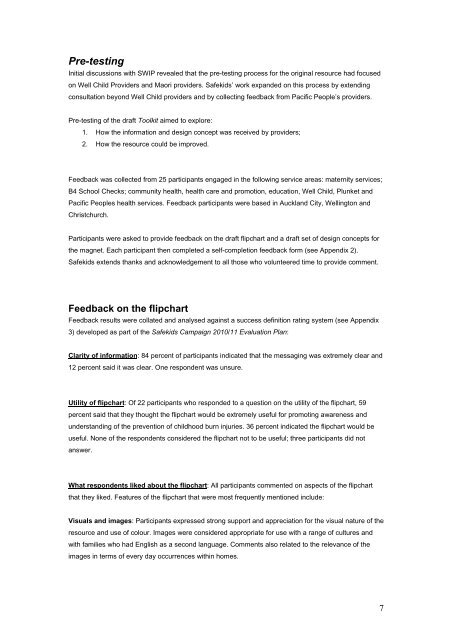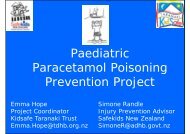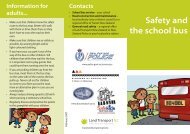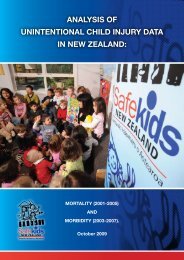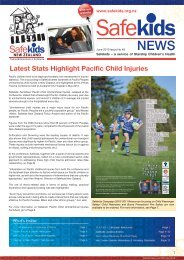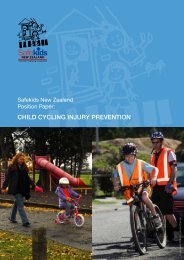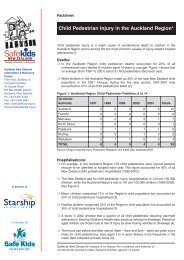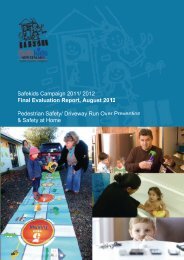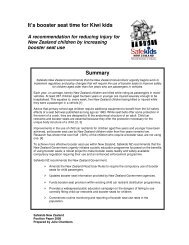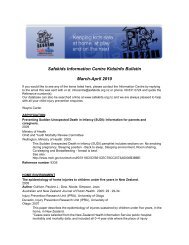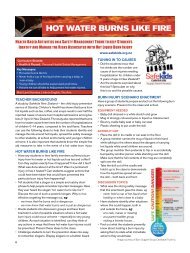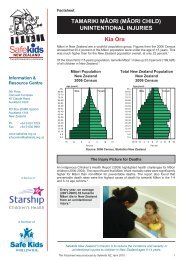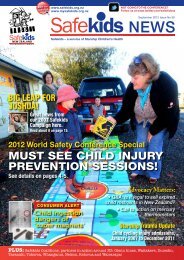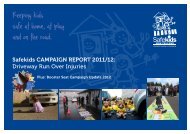Safekids Campaign 2010/11: Fire Safety/ Burns Prevention Contents
Safekids Campaign 2010/11: Fire Safety/ Burns Prevention Contents
Safekids Campaign 2010/11: Fire Safety/ Burns Prevention Contents
You also want an ePaper? Increase the reach of your titles
YUMPU automatically turns print PDFs into web optimized ePapers that Google loves.
Pre-testing<br />
Initial discussions with SWIP revealed that the pre-testing process for the original resource had focused<br />
on Well Child Providers and Maori providers. <strong>Safekids</strong>’ work expanded on this process by extending<br />
consultation beyond Well Child providers and by collecting feedback from Pacific People’s providers.<br />
Pre-testing of the draft Toolkit aimed to explore:<br />
1. How the information and design concept was received by providers;<br />
2. How the resource could be improved.<br />
Feedback was collected from 25 participants engaged in the following service areas: maternity services;<br />
B4 School Checks; community health, health care and promotion, education, Well Child, Plunket and<br />
Pacific Peoples health services. Feedback participants were based in Auckland City, Wellington and<br />
Christchurch.<br />
Participants were asked to provide feedback on the draft flipchart and a draft set of design concepts for<br />
the magnet. Each participant then completed a self-completion feedback form (see Appendix 2).<br />
<strong>Safekids</strong> extends thanks and acknowledgement to all those who volunteered time to provide comment.<br />
Feedback on the flipchart<br />
Feedback results were collated and analysed against a success definition rating system (see Appendix<br />
3) developed as part of the <strong>Safekids</strong> <strong>Campaign</strong> <strong>2010</strong>/<strong>11</strong> Evaluation Plan:<br />
Clarity of information: 84 percent of participants indicated that the messaging was extremely clear and<br />
12 percent said it was clear. One respondent was unsure.<br />
Utility of flipchart: Of 22 participants who responded to a question on the utility of the flipchart, 59<br />
percent said that they thought the flipchart would be extremely useful for promoting awareness and<br />
understanding of the prevention of childhood burn injuries. 36 percent indicated the flipchart would be<br />
useful. None of the respondents considered the flipchart not to be useful; three participants did not<br />
answer.<br />
What respondents liked about the flipchart: All participants commented on aspects of the flipchart<br />
that they liked. Features of the flipchart that were most frequently mentioned include:<br />
Visuals and images: Participants expressed strong support and appreciation for the visual nature of the<br />
resource and use of colour. Images were considered appropriate for use with a range of cultures and<br />
with families who had English as a second language. Comments also related to the relevance of the<br />
images in terms of every day occurrences within homes.<br />
7


